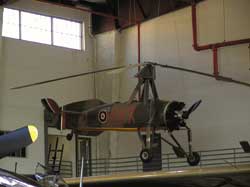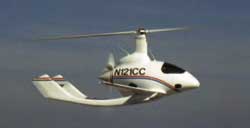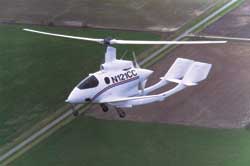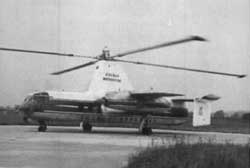|
|

|
The CarterCopter
|
|
The Next Big Thing in Aviation
|
By Henry Farkas and Claudius Klimt
Speed of travel is one of the big things that distinguish eras of human history. In the second half of the 20th century, the turbojet engine revolutionized air travel, both in fixed, and rotary winged aircraft. But for the past thirty years, improvements in air travel have been almost non-existent. Jet planes fly passengers at about the same speeds they flew thirty years ago. Range has improved. Comfort has declined.
Large passenger jets need huge airports because they need runways two miles long, or longer. It costs billions of dollars just to build a new runway, much less a new commercial airport, to ease air traffic congestion. Something new is needed, desperately. Jay Carter has what we need.
Aircraft are still limited by the speed of sound. Supersonic flight is noisy and expensive because of those pesky sonic booms. But the speed of the aircraft is only one component of a trip by air. There are lots of airplane trips where the time spent on the ground is literally longer than the time spent in the air. Getting through traffic jams while going to the airport, or going really far out of the city to get to the airport, takes up lots of time.
General aviation airports need runways in the two to five thousand foot range. That takes up real estate that's often gobbled up by other, more remunerative, land uses, so owning your own plane isn't nearly as convenient as it used to be when there were more GA airports, and when they were closer to the city. Too many GA airports have been swallowed up by housing developments and strip malls. The GA airport where I took my first flight in a small plane is now a housing development. The GA airport where I learned to fly is now an industrial park. We need a way to have general aviation airports that don’t need such long runways so they can pay less real estate tax and stay in business as airports. Again, Jay Carter has what we need.
If you're wealthy, you can fly a helicopter. Heliports take up less land. People with big back yards can keep their helicopters at home. Lots of medium sized businesses have heliports. But helicopters have lousy gas mileage, they're noisy, they're slow, and they need lots of maintenance.
Jay Carter did some math and figured out a way to make an aircraft that wouldn't need long runways, but that would be fast and fuel efficient. He built an autogiro with wings. An autogiro is a rotorcraft that gets lift from passively spinning rotors and thrust from a propeller.
In May of 1924, Don Juan de la Cierva of Spain produced a rotary wing aircraft, the C.6A, that actually flew. The British Air Ministry got further models built. The C.30A in the picture below, photographed at the Fantasy of Flight Aviation Museum in Polk City, Florida, was built in 1934 as an artillery spotter for the British Army.

Autogiros actually fly, and some are flown today, but the design is flawed. Although they're capable of very short takeoff and landing, the autogiro is inherently slow, so it's not viable as a useful passenger or commercial aircraft.
Now, here's Jay Carter's vision. If you could build a hybrid aircraft that would have the takeoff and landing characteristics of an autogiro, but the flight characteristics of an airplane, you could use it from smaller airports that could be closer to population centers because it wouldn't need as much valuable real estate, and it could be designed to fly faster than most subsonic aircraft.
Why faster? Because the wing is designed like a jet aircraft wing. It's smaller, and has a higher aspect ratio than the standard fixed wing aircraft. In fact, the CarterCopter wings are 20-25% the size of a conventional fixed wing aircraft of the same gross weight. Since the wings are not used for takeoffs and landings, they are designed specifically for low profile drag and low induced drag -- to be very efficient at high forward speeds and high altitudes.
Since the rotor provides lift at times when slow and intermediate speeds are appropriate, the wing can be sized very small, too small for takeoff and landing, and yet provide all the lift needed for cruise conditions. This combination of a very small, high aspect ratio wing with a slow turning rotor results in significantly less net lifting surface drag than a comparable weight fixed wing propeller-driven aircraft.
The design means that the wing won't support the entire weight of the aircraft below a speed of 150 mph at sea level. Clearly, the FAA won't let you build a fixed wing GA aircraft with a stall speed, and therefore, a landing and takeoff speed of 150 mph. However, the CarterCopter can have that kind of highly efficient wing because it also has a rotor for low speed flight.
The reason the wings on airplanes are inefficient is that they have to be designed with a low enough stall speed so that they can take off and land on a runway that's short enough to fit inside an airport. Well, the definition of a short enough runway is getting smaller as real estate values go up. Jay's hybrid aircraft, the CarterCopter, can take off like a helicopter, accelerate to appropriate flying speed whioe already in the air, and then switch to more efficient fixed wing mode at a higher speed because the small wing has much less drag than a normal wing would have.
OK, the perspicacious readers will quibble about some of the points I just made. They'll say that autogiros don't actually take off like helicopters because the rotors are unpowered. Well, it's true that they're unpowered in flight, but they're spun up under power before takeoff. That's not new. What's new is that Jay added depleted uranium weights to the outer ends of the rotors to give them enough stored angular momentum so that even when the engine power is switched from the rotors to the pusher prop, the stored angular momentum in the rotors allows vertical takeoff using the helicopter-like collective and acceleration using the combined cyclic/control stick. The control stick acts like a cyclic while the CC is in rotorcraft mode and like a normal airplane control stick once the CC is in fixed wing mode. The transition is transparent to the pilot.
 More technically inclined readers will quibble about the drag induced by the rotor blades, which will still be up there in the air stream while the CC is flying in fixed wing mode. It turns out that the drag is proportional to the cube of the RPM of the rotors so that slowing the rotors while in fixed wing mode reduces their drag a lot. Decreasing the RPM from 300 to 100, a drop to 1/3 the RPM needed for takeoff or landing, reduces the induced drag by a factor of 27. That is, there's 1/27th the amount of drag from the rotors when they're slowed to 100 RPM. And the rotors can be slowed because of the weights at the ends of the rotors. Jay calculated that the rotors would remain stable at 100 RPM because of the weighted ends. The extra weight and strength needed to produce rotors that could be stopped in flight would cause more drag. That design would be less power efficient than the current design which keeps the rotors spinning at 100 RPM. More technically inclined readers will quibble about the drag induced by the rotor blades, which will still be up there in the air stream while the CC is flying in fixed wing mode. It turns out that the drag is proportional to the cube of the RPM of the rotors so that slowing the rotors while in fixed wing mode reduces their drag a lot. Decreasing the RPM from 300 to 100, a drop to 1/3 the RPM needed for takeoff or landing, reduces the induced drag by a factor of 27. That is, there's 1/27th the amount of drag from the rotors when they're slowed to 100 RPM. And the rotors can be slowed because of the weights at the ends of the rotors. Jay calculated that the rotors would remain stable at 100 RPM because of the weighted ends. The extra weight and strength needed to produce rotors that could be stopped in flight would cause more drag. That design would be less power efficient than the current design which keeps the rotors spinning at 100 RPM.
Some of you are thinking that this is just another Osprey V-22. In a sense, the Osprey is also a hybrid aircraft with fixed wing and helicopter characteristics. The differences are important to people who may want to buy a hybrid aircraft for personal use, or even to fly in one. The Osprey, as we all know, depends on the ability to tilt the rotors upward at a 90 degree angle from the line of flight in order to get into helicopter mode. There's a lot of heavy machinery needed in each wing root in order to do that, so the Osprey is inherently heavy and requires two turboprop engines to lift all that stuff. It also can't land in airplane mode. The props, which become the rotors in helicopter mode, are so large that they'd cause a crash if the pilot tried to land with the wings horizontal. The props would hit the ground before the landing gear touched down. If there were a malfunction that prevented the rotors from tilting upward, the aircraft would not be able to land without damage.
 The CarterCopter can be run on a single piston engine. They're doing the flight testing with a Corvette automobile engine. In the event of power loss at altitude, which happened once during the flight testing program, the pilot does what any fixed wing pilot would do. He glides to a landing. But the landing, off a runway, will be much softer than it would be in a fixed wing aircraft because during the late phase of the landing glide, the pilot uses the descent of the plane to speed up the rotors, and then just lands vertically. This is an aircraft that civilians can afford and that is actually safer in an off airport, power off landing than a normal fixed wing airplane would be. The CarterCopter can be run on a single piston engine. They're doing the flight testing with a Corvette automobile engine. In the event of power loss at altitude, which happened once during the flight testing program, the pilot does what any fixed wing pilot would do. He glides to a landing. But the landing, off a runway, will be much softer than it would be in a fixed wing aircraft because during the late phase of the landing glide, the pilot uses the descent of the plane to speed up the rotors, and then just lands vertically. This is an aircraft that civilians can afford and that is actually safer in an off airport, power off landing than a normal fixed wing airplane would be.
Now, let's talk about autorotation for a moment. Helicopter pilots practice autorotation so that they'll be able to land if they lose power. A normal helicopter flies because the engine spins the rotor. The rotor causes a downdraft that's stronger than the weight of the helicopter. If the helicopter loses power, the pilot needs to get it into autorotation mode. Autorotation means that the helicopter becomes like a gyrocopter, that is, the force of air going up past the rotors spins them enough to give the aircraft some lift. A helicopter can't climb without power when it's autorotating. It can, however, glide to a flat spot (with a truly lousy glide ratio) and land nearly vertically. But there's something called a dead man zone. That is, if the helicopter loses power when it's too close to the ground to get into autorotation mode, it will just fall to the ground, kind of like a rock.
The CarterCopter rotors are under power from the engine only before departure. If the rotor were powered after leaving the ground, the aircraft would be a helicopter, and, as such, would need a tail rotor to keep it from spinning like a top. More weight. More maintenance. As the CarterCopter leaves the ground, the power to take off vertically comes from the stored angular momentum of those depleted uranium weights Jay Carter put at the ends of the rotors. No tail rotor is needed to keep the aircraft pointing in the right direction because the power isn't coming from the body of the aircraft. It's coming from the stored angular momentum of the rotors. Even if the engine quits on departure, the stored angular momentum is still there and can be used to land the aircraft. By the time the rotors are slowed to 100 RPM, the CarterCopter is at sufficient altitude so that the glide to the ground can be used to speed the rotors up even without engine power.
Now let's talk about hovering. Yes, it's true. Gyrocopters can't hover. Because of the weighted rotors, the CarterCopter can hover for about five seconds. But that's not enough to replace the ability of a helicopter to hover until it runs out of fuel. It turns out that about 80% of helicopter missions don't require any hover time. But nobody is suggesting that we won't need helicopters once the CarterCopter is developed. We just won't need as many.
Private, fixed wing propeller driven aircraft may not be needed once the price of a CarterCopter is in the same range as a comparably sized fixed wing airplane because the CarterCopter's speed will be faster and its fuel efficiency and safety will be greater.
Now you might be thinking, OK, nice concept, but does it actually fly. Well, yes. It does.
Imagine, if you will, the Wright brothers on a windswept area of sand dunes, living in tents, and experimenting with flying machines they built, and designed, themselves. The best scientific equipment of that time could be built by an intelligent person with a good education, and that's what the Wright brothers were.
Jay Carter and his group are kind of like them, but they have carbon fiber, Kevlar, personal computers, video cameras, and sensors to record the gory details of every flight. When something breaks, Jay and his people both rebuild it and improve it.
Their website, www.cartercopters.com, tells you about every problem as well as every success. That Corvette engine has flown the CarterCopter at 170 miles an hour, and they haven't even figured out, for sure, what the top speed or top altitude will ultimately be. In mid 2001, they had a catastrophic failure of a prop spinner at altitude. There are dramatic pictures taken with the tail mounted video camera at the web site. The test pilots had to power down the engine, glide back to the runway, and land without power. They did that without any damage other than the original damage to the prop spinner. This is going to be the VTOL aircraft for the rest of us. Pilots will be able to land at airports, heliports, and in large back yards. Look at the pictures.
One last concept. You may ask, after seeing the pictures of the "concept" CarterCopter commercial transports, whether the CarterCopter concept can be scaled up to commercial aircraft size and still fly. Yes, it can.
 It turns out that this has been done before. In 1956, the Fairey Aircraft Company in England built a prototype 50 passenger aircraft called the Fairey Rotodyne. It was powered by two turboprop engines. It had a four bladed rotor that was powered by air jets at the ends of the rotors so it could take off and land in helicopter mode. It had wings that took up most, but not all of the lift at cruise speeds. It cruised at 195 miles an hour. It worked, but the jets at the ends of the rotors were quite noisy, and although the company was able to decrease the noise output, the aircraft was never mass produced. The point is, the prototype was a full sized commercial aircraft. It turns out that this has been done before. In 1956, the Fairey Aircraft Company in England built a prototype 50 passenger aircraft called the Fairey Rotodyne. It was powered by two turboprop engines. It had a four bladed rotor that was powered by air jets at the ends of the rotors so it could take off and land in helicopter mode. It had wings that took up most, but not all of the lift at cruise speeds. It cruised at 195 miles an hour. It worked, but the jets at the ends of the rotors were quite noisy, and although the company was able to decrease the noise output, the aircraft was never mass produced. The point is, the prototype was a full sized commercial aircraft.
It flew. The CarterCopter can be scaled up the same way, and the weights at the ends of the rotors won't make any noise so the commercial transport version of the CarterCopter will be able to use small airports near cities. It won't need big runways.
Once the CarterCopter breaks the Mu 1 barrier (forward speed greater than the speed of the retreating rotor), aircraft companies will be quite interested in licensing the CC technology. There will be kit planes for people who like to build their own, private, certificated planes for people who like to fly, but who don’t have the skills or free time to build their own, large military and civilian transports, and unpiloted surveillance and attack aircraft for military applications.
On March 22, 2002, the CarterCopter flew at Mu 0.87. This is a much higher Mu than any other rotorcraft has ever flown, so Mu 1 shouldn’t take much more testing and refining. CarterCopter is well on their way to proving their innovative approach to a high speed VTOL aircraft. Look for this technology to arrive at an airport near you in the not too distant future.
|
Click here to return to the beginning of this article.  |
|